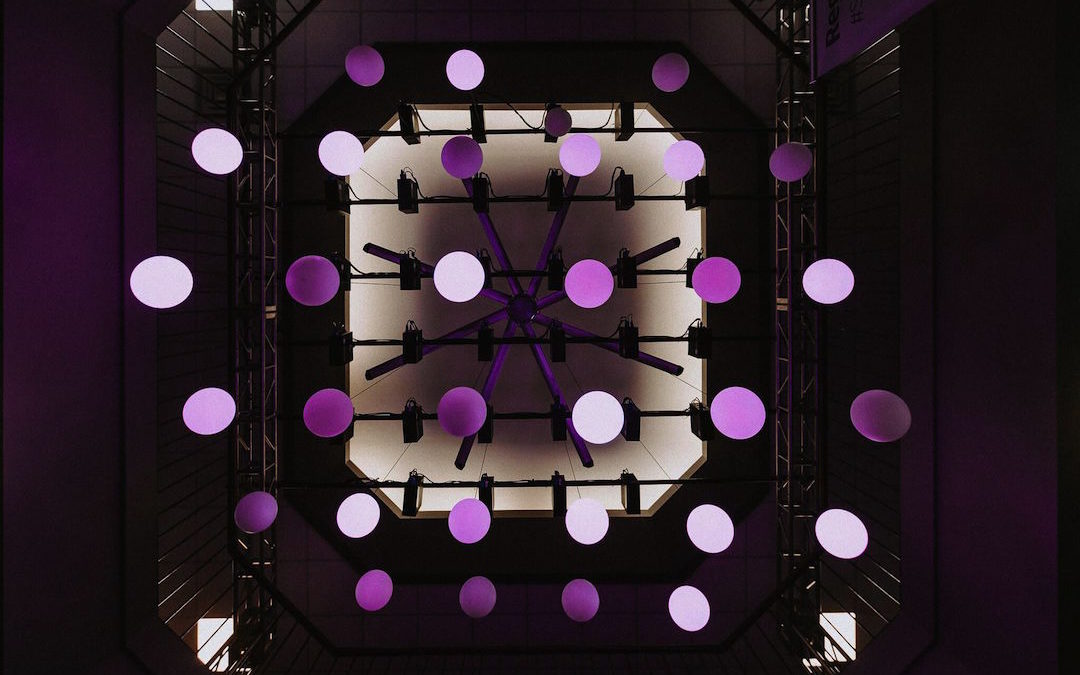Welcome to the next episode of the Mod Scenes podcast.
This is episode 1 0 8. Uh, today we will be talking about stage designs, uh, and stage backdrops, particularly height, limitations of stage backdrops. Um, so, uh, we have a lot of different products for a lot of different uses, uh, and a lot of different patterns, um, that are all precision cut with a CNC. Uh, they look amazing. They take white grade, uh, they’re phenomenal at creating a great atmosphere for your church stage for your, uh, corporate event for your product launch for, uh, really any atmosphere you’re trying to create. Um, we’ve done lots and lots of different, um, different
Projects ranging from the smallest backdrop, um, you know, six foot by four foot, uh, for a little itty-bitty photo
Booth singular photo booth space to
A huge, massive, uh, designs in arenas like, uh, American airlines center
Over 600 panels in that design. Um, so we have a large, vast array of not only designs, but expertise in serving different clients and different needs for your stage backdrops. So when we, when we’re creating your stage backdrop, we obviously want to create the best stage backdrops possible. Um, and one of the things to take into mind is your height limitations in your room. So a lot of churches, uh, in particular, uh, so churches looking to make a new church stage design, uh, they use, uh, they try to use every, every inch of height possible. Uh, however, a lot of times, uh, they also are in the position where they are working with a limited budget, uh, which can also become a kind of a crunch. So a couple of things we can do to work around that is to lower the height of the ceiling, uh, sort of, uh, not actually in actuality, but the visual height of the ceiling.
So a lot of, a lot of churches they’ll have, um, they’ll have their moving lights hung at the, you know, the top of their ceiling. And so those lights are going to be hanging down, you know, say like a foot, two foot, uh, depending on how they’re hung. They could be as far as four foot down, if they’re on motors. So all that space there, we don’t necessarily want to fill that space with a white pattern behind it. Cause we have black moving lights on front of a white pattern. Uh, it just becomes kind of a, uh, over, uh, it doesn’t look as clean. It doesn’t look quite, quite as good.
So what in that kind of situation, what we can do is we can drop down a pipe, uh, like a steel, um, like a steel, uh, gas pipe, uh, like you would see like a schedule 40 pipe you would see used in a lighting design, uh, and you could drop one of those downs, say forefoot and then start building there. Uh, and that’s gonna, it’s gonna make your, uh, finished product look a little nicer, cause you don’t have anything blocking the actual scenic. Um, but B it’s also going to save you two rows of scenic, which is going to be, it’s going to add up pretty quickly. Um, it could, you know, reduce it by 10, 20% depending on how big your stages. Um, so, uh, in addition to that, um, my apologies, uh, in addition to that,
You can also, um,
There’s also a couple of things to look for. If you’re using a stage backdrop, you’re trying to build the stage backdrop to fit the, you know, to fit the height and size of your room.
Uh, but B you also want to make sure you’re within the limitations. Uh, most of our products are, have some pretty high limits as far as their height usability. Uh, once you get over about 20 feet on the Crescent moon panels, uh, it gets to be a little bit, uh, a little bit more difficult to use because the Crescent moon Danimals have, uh, almost 60% of their, uh, material cutaway actually, it’s even more than that. Uh, so there’s a lot of material cutaway, so there’s a, it’s hard for it to transfer weight as well as some of the other panel types. Uh, so, uh, one thing to keep in mind is if you’re going to go above a 20 foot distance on your next stage backdrops, uh, with the Crescent moon beam holes, um, make sure that stage backdrop is utilizing our Crescent moons made a fire to PBC.
They have a, uh, they have, uh, they’re a stronger material and they can do taller Heights. So you should be able to get a solid, uh, 30, uh, 30 feet tall with, uh, with a Mod scenes, uh, PVC panel, uh, made with the Crescent moons. So it’s a great option if you’re looking to make a tall stage backdrop, uh, that backdrop panels like our canvas, uh, can work up boards of 50 feet, uh, in many of the other designs, uh, work within the 30 to 50 feet range. Uh, if you have a specific question about trying to get a specific height, uh, let us know, and we can do calculations and let you know exactly how tall you can make that backdrop before you start seeing, uh, deformations. So one of the things that’ll never happen is you’ll never have your backdrop fail. Your stage, backdrop will not collapse, or your church stage is, is not gonna fall over or anything.
Uh, what would happen is you just start to see deformities that that light will pick up. So for Crescent moons, for example, if you hang Crescent, moons, 30 foot tall, uh, out of fire rated Coro, the top one to three rows is going to start to buckle a little bit under the weight of the rows below it, uh, in the top will bend a little bit, uh, which actually it looks kind of cool. Um, however, typically is not the look you’re going for at that point. Uh, so, um, uh, so yeah, so you take, uh, you take in that situation and just go, uh, upgrade to the proceeds PVC, uh, or you can split the design into, uh, do a point at the top at 30 feet, or you can Hindu a second point, uh, about the middle, um, at about 15 feet. Uh, and that’ll give you the ability to hang your height with the cheaper, uh, fire Reddick Coroplast products.
Um, however, it’ll also give you the ability to, um, not have to spend as much on the plastic, uh, if that’s a concern. So, uh, I hope I hope this was, uh, eye opening, uh, podcast for you. Um, but I have a few other things I want to chat about, uh, specifically about, uh, backdrop design in a tall room. So tall rooms, uh, are notoriously challenging because they eat up space like nobody’s business. Um, you know, if you have a 20, 25, 30 foot tall room, and you’re trying to build a scenic Saturday, uh, it starts to get real expensive because you’re having to add up, add lots and lots of panels just to hit that height. Uh, so there’s a few things you can do to kind of maximize your, uh, maximize your impact and minimize your costs. Uh, one of my favorite things to do in that situation is to take a, um, uh, one of my favorite things to do in those situations is to take a, a different approach instead of doing a, you know, a giant panel wall, uh, is to go through and do columns.
So do two to four foot wide strips, uh, backdrop material, and then two to four foot wide strips, uh, uh, blank material. Uh, and then if you’re using a solid church states’ design or any early stage backdrops design, uh, your, your stage backdrop is going to cost about half the price extreme, half the payables. Uh, another way you can do it is you can hang it, uh, kinda change the orientation of the panels, rotate them about 45 degrees, uh, and hang them, uh, like a diamond. Uh, so that your top point is going to go up to your grid. Your bottom point is going to connect to a panel below it, and you’re going to do kind of a trucker report, but on a diamond orientation, uh, that looks really good. And it saves again, half as many panels. Uh, it has a really unique look. Um, in addition to that, you can also randomly hang the panels, um, which creates a cool kind of vibe, uh, or you can build, uh, cubes. So
On our website, we actually have a cute package, which includes six panels and all the needed hardware, um, which are incredible because you actually get a pretty good discount per panel on those, uh, and you get to hang those in your space, um, randomly. And so instead of needing, you know, 300 panels for a backdrop, you can do, you know, 150 or 200 panels,
Um, and have a bunch of, uh, randomly laid out pieces, which, uh, I think is pretty cool. Um,
So yeah, and in conclusion
In conclusion, uh, there’s a lot of different options you can use for creating a stage backdrops in a space where you’re, uh, you know, height as a challenge, whether it be too high. Uh, and there’s a lot of other, uh, there’s some other things we can do if you’re a space too low, uh, which I’ll, I’ll touch on another podcast in the future. Um, but if you do have a stage backdrop, regardless of your height, that looking to update and make, uh, make new, make it look beautiful, I’d love to help you with that. I’d love to serve you and your team. Uh, you can reach out to us and our team. Uh, my name is Steven. You can reach out to me at Stephen at [inaudible] dot com or by phone at (530) 623-7421. Or by checking out our website@mazzianz.com. I’m looking forward to serving you and creating an incredible stage backdrop for your next event or next church stage design. Uh, give us a call and let us know how we can serve your best. Thanks again for tuning into the mind scenes podcast. And we will chat with you soon.


Recent Comments